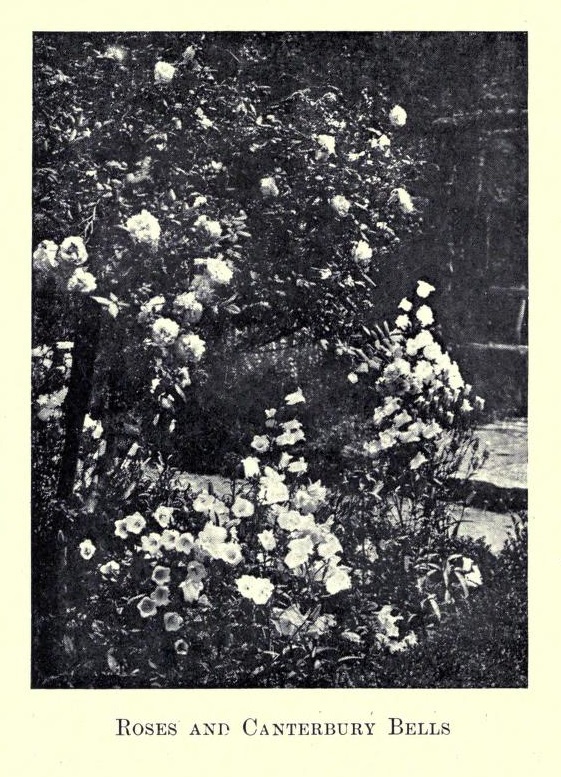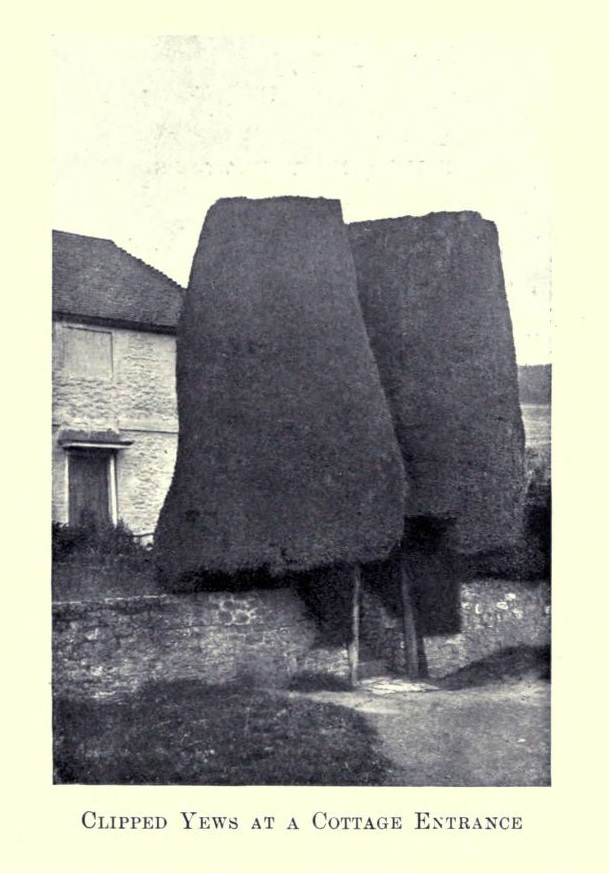
Cottage porch from Old West Surrey (1904) by Gertrude Jekyll (University of California Libraries)
Gertrude Jekyll’s Old West Surrey Some Notes and Memories (1904) represents something of a departure from her vast output of books and articles about plants and garden design. This study of the locality around her home at Munstead Wood reveals an enthusiasm for all aspects of vernacular architecture and the rural way of life in this part of southern England, which was rapidly disappearing at the beginning of the twentieth century.
Illustrated with dozens of Jekyll’s photographs, details of farm buildings and cottages, trades, furniture, tools and everyday household articles are documented – and, of course, the people she encountered on her travels. Jekyll dedicates a whole chapter of her book to the cottage garden, praising both the skill of the cottage gardener, and the dedication needed to maintain the displays of flowers over the season.
This style of gardening, with roses framing the front door and a profusion of flowers in the borders, was a favourite of Jekyll’s and examples of cottage gardens regularly appear in her other published works. These gardens are still deservedly popular, despite associations of sentimentality and nostalgia, perhaps because this unpretentious style of planting complements smaller houses so well. Any meanness in the scale of the building is softened and the cottage front garden, in particular, lifts the spirits of passers-by as well as providing pleasure for the owners themselves.
Here follow Jekyll’s photographs of cottage gardens from Old West Surrey together with some of her observations about them. Her detailed knowledge of plants makes this a useful resource for anyone wishing to re-create a cottage garden from this period. Links to the text below:

‘The most usual form of the cottage flower-garden is a strip on each side of the path leading from the road to the cottage door. But if the space is a small one, it is often all given to flowers. Sometimes, indeed, the smaller the space the more is crammed into it. One tiny garden I used to watch with much pleasure, had nearly the whole space between road and cottage filled with a rough staging. It was a good example of how much could be done with little means but much loving labour. There was a tiny green-house, of which the end shows to the left of the picture, that housed the tender plants in winter, but it could not have held anything like the quantity of plants that appeared on the staging throughout the summer. There were hydrangeas, fuschias, show and zonal geraniums, lilies and begonias, for the main show; a pot or two of the graceful francoa, and half-hardy annuals cleverly grown in pots; a clematis smothered in bloom, over the door, and, for the protection of all, a framework, to which a light shelter could be fixed in case of very bad weather.
It must have given pleasure to thousands of passers-by; to say nothing of the pride and delight that it must have been to its owner.’


‘There is scarcely a cottage without some plants in the window; indeed the windows are often so much filled up with them that the light is too much obscured. The wise cottagers place them outside in the summer, to make fresh growth and to gain strength. These window plants are the objects of much care, and often make fine specimens.’

‘The deep-rooting Everlasting Pea (Winterbean is its local name) is a fine old cottage plant, and Nasturtiums ramble far and wide. Nowhere else does one see such Wallflowers, Sweet-Williams, and Canterbury Bells, as in these carefully-tended little plots.’


‘Here and there is a clipped yew over a cottage entrance; but this kind of work is not so frequent as in other parts of the country.’

‘China Asters are great favourites – ‘Chaney Oysters’ the old people used to call them – and Dahlias, especially the tight, formal show kinds are much prized and grandly grown.
Sweet smelling bushes and herbs, such as rosemary, lavender, southernwood, mint, sage and balm, or at least some of them were to be found in the older cottagers’ garden plots.’


From Wood and Garden, first published in 1899.

Quintessential cottage garden from Wood and Garden first published 1899.
Further reading:
